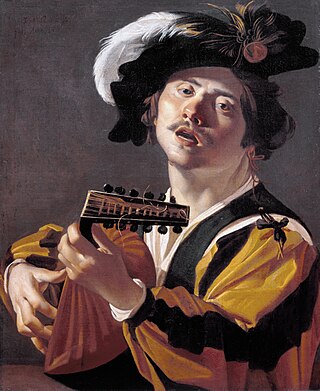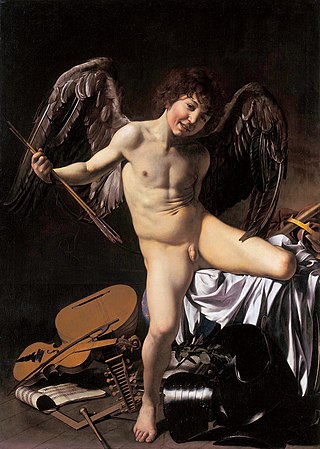
Dirck Jaspersz. van Baburen was a Dutch painter and one of the Utrecht Caravaggisti.

The Caravaggisti were stylistic followers of the late 16th-century Italian Baroque painter Caravaggio. His influence on the new Baroque style that eventually emerged from Mannerism was profound. Caravaggio never established a workshop as most other painters did, and thus had no school to spread his techniques. Nor did he ever set out his underlying philosophical approach to art, the psychological realism which can only be deduced from his surviving work. But it can be seen directly or indirectly in the work of Rubens, Jusepe de Ribera, Bernini, and Rembrandt. Famous while he lived, Caravaggio himself was forgotten almost immediately after his death. Many of his paintings were re-ascribed to his followers, such as The Taking of Christ, which was attributed to the Dutch painter Gerrit van Honthorst until 1990.

Gerard van Honthorst was a Dutch Golden Age painter who became known for his depiction of artificially lit scenes, eventually receiving the nickname Gherardo delle Notti. Early in his career he visited Rome, where he had great success painting in a style influenced by Caravaggio. Following his return to the Netherlands he became a leading portrait painter. Van Honthorst's contemporaries included Utrecht painters Hendrick Ter Brugghen and Dirck van Baburen.

Orazio Lomi Gentileschi (1563–1639) was an Italian painter. Born in Tuscany, he began his career in Rome, painting in a Mannerist style, much of his work consisting of painting the figures within the decorative schemes of other artists.

Amor Vincit Omnia is a painting by the Italian Baroque artist Caravaggio.

The Calling of Saint Matthew is a painting by Caravaggio, depicting the moment at which Jesus Christ inspires Matthew to follow him. It was completed in 1599–1600 for the Contarelli Chapel in the church of the French congregation, San Luigi dei Francesi in Rome, where it remains. It hangs alongside two other paintings of Matthew by Caravaggio, The Martyrdom of Saint Matthew and The Inspiration of Saint Matthew (1602).

The Lute Player is a composition by the Italian Baroque master Caravaggio. It used to exist in two versions, one in the Wildenstein Collection and another in the Hermitage Museum, St. Petersburg. A third version, which was kept for 275 years at Badminton House, Gloucestershire, came to light in 2001, and which today is understood to be the original version. The Hermitage and the Badminton House versions were exhibited together in 2020 at the Galleria Borghese.

The Cardsharps is a painting by the Italian Baroque artist Michelangelo Merisi da Caravaggio. The original is generally agreed to be the work acquired by the Kimbell Art Museum in 1987, although Caravaggio may have painted more than one version.

The Denial of Saint Peter(La Negazione di Pietro) is a painting finished around 1610 by the Italian painter Caravaggio. It depicts Peter denying Jesus after Jesus was arrested. The painting is housed in the Metropolitan Museum of Art in New York City.

The Musicians or Concert of Youths is a painting by the Italian Baroque master Michelangelo Merisi da Caravaggio (1571–1610). The work was commissioned by Cardinal Francesco Maria del Monte, who had an avid interest in music. It is one of Caravaggio more complex paintings, with four figures that were likely painted from life.

Francesco Maria del Monte, full name Francesco Maria Bourbon del Monte Santa Maria, was an Italian cardinal, diplomat, and connoisseur of the arts. His fame today rests on his early patronage of the important Baroque master Caravaggio, and on his art collection which provides provenance for many important works of the period.

Cornelis de Vos was a Flemish painter, draughtsman and art dealer. He was one of the leading portrait painters in Antwerp and is best known for his sensitive portraits, in particular of children and families. He was also successful in other genres including history, religious and genre painting. He was a regular collaborator with Rubens.

Valentin de Boulogne, sometimes referred to as Le Valentin, was a French painter in the tenebrist style.

Pietro Paolini, called il Lucchese was an Italian painter of the Baroque period. Working in Rome, Venice and finally his native Lucca, he was a follower of Caravaggio to whose work he responded in a very personal manner. He founded an Academy in his hometown, which formed the next generation of painters of Lucca.

Nicolas Régnier (1591–1667), known in Italy as Niccolò Renieri, was a painter, art dealer and art collector from the County of Hainaut, a French-speaking part of the Spanish Netherlands. He is often referred to as a Flemish artist because this term was often used to designate people from the Spanish Netherlands. After training in Antwerp, he was active in Italy where he was part of the international Caravaggesque movement. His subjects include genre scenes with card players, fortune tellers, soldiers and concerts, religious scenes, saints, mythological and allegorical scenes, and portraits. He also painted a few scenes with carnivals.

Theodoor Rombouts was a Flemish painter who is mainly known for his Caravaggesque genre scenes depicting lively dramatic gatherings as well as religiously-themed works. He is considered to be the primary and most original representative of Flemish Caravaggism. These Caravaggisti were part of an international movement of European artists who interpreted the work of Caravaggio and the followers of Caravaggio in a personal manner.

Bartolomeo Cavarozzi (1587–1625), occasionally referred to as Bartolomeo Crescenzi, was an Italian caravaggisti painter of the Baroque period. Cavarozzi's work begin receiving increased admiration and appreciation from art historians in the last few decades of the 20th century, emerging as one of the more distinct and original followers of Caravaggio. He received training from Giovanni Battista Crescenzi in Rome and later traveled to Spain alongside his master for a few years where he achieved some renown and was significant in spreading "Caravaggism" to Spain before returning to Italy. His surviving works are predominantly Biblical subjects and still-life paintings, although older references note he "was esteemed a good painter especially of portraits".

The Lute Player is a painting from c. 1612–1615 by the Italian artist Orazio Gentileschi (1563–1639) depicting a young woman in a golden dress with a lute.

Soldier Playing the Theorbo is an oil on canvas painting by French artist Ernest Meissonier, created in 1865. The painting depicts a soldier playing a theorbo. The painting is in the collection of the Metropolitan Museum of Art, in New York.

The Fortune Teller, also known as the Fortune Teller with Soldiers, is an oil on canvas painting dating to approximately 1620 by French painter, Valentin de Boulogne, a follower of Caravaggio. It is now held in the Toledo Museum of Art, in Toledo, Ohio. The scene depicts a group of men around a fortune teller that was attributed by Gustav Friedrich Waagen.




















